The Best Rome Tour in 48 Hours
Are you ready to take an unforgettable journey through an engaging Rome tour? Any trip to Italy would be incomplete without exploring Rome, the Eternal City.
Rome is a place where you can literally walk amongst the ruins of its two and a half thousand-year-old history. The impressive squares, the churches, the ancient sites and many other charming places make you feel really special when you will spend even just two days in the Italian capital.
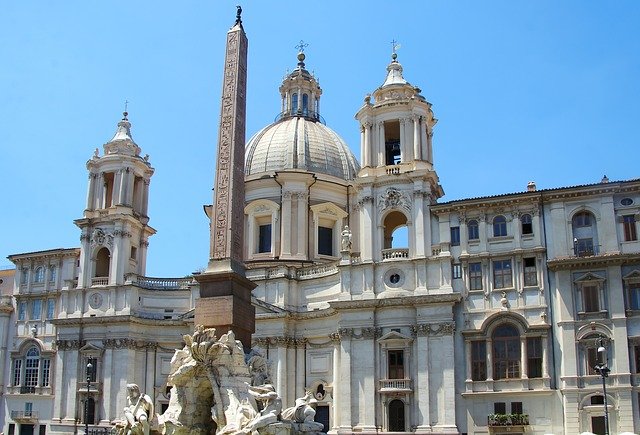 One could spend a week in this ancient city and still not see everything it has to offer. However, there are a few places in Rome that are considered “must-see” attractions due to their high-profile artistic, historical, and cultural values. They are some of the world’s ultimate sites to be seen and are on every world traveller’s checklist.
One could spend a week in this ancient city and still not see everything it has to offer. However, there are a few places in Rome that are considered “must-see” attractions due to their high-profile artistic, historical, and cultural values. They are some of the world’s ultimate sites to be seen and are on every world traveller’s checklist.
With its vast archaeological treasures, world-renowned art collections and cultural heritage around every corner, it’s no surprise that the best things to do in Rome are some of the very best all across the world.
Ideally, you should plan to spend at least two days in Rome in order to see all of its main sites properly. To take full advantage of this 2 days Rome tour, we recommend arriving there as early as possible (or the night before) and have 2 full days before you leave.
To get the most out of your Rome tour, you will need to do a bit of forward planning and even reserve your entry time to the key attractions – otherwise you’ll waste your time standing in lines unnecessarily.
But don’t just tick off your bucket list items, take the time to soak in the vibrant aura of the city. Wander the streets, head out to the suburbs, eat where the locals do, enjoy the effervescence of this grand Italian city!
In order to help you plan your stay, here THE BEST 13 THINGS TO DO IN ROME, with all the must-see attractions and points of interest.
The Colosseum – The Iconic Symbol of Rome
 First on the list, during your Rome tour, is a visit to the Colosseum, probably the most famous landmark in Rome. Built in the 1st century AD, this great arena could seat 45,000 spectators and was the largest Roman amphitheatre in the world. It hosted gladiatorial combats, spectacles with wild beasts and possibly the execution of early Christians.
First on the list, during your Rome tour, is a visit to the Colosseum, probably the most famous landmark in Rome. Built in the 1st century AD, this great arena could seat 45,000 spectators and was the largest Roman amphitheatre in the world. It hosted gladiatorial combats, spectacles with wild beasts and possibly the execution of early Christians.
A visit to the arena is pleasant and allows you to get a sense of the size of the Colosseum from the inside and how it must have felt to be there to see a game. Once inside, you can see the underground chambers and passageways that were originally covered by a wooden floor (called the hypogeum).
These passageways were used to transport animals and gladiators in the arena. Today, nearly 4 million people annually visit the Colosseum. Buy your tickets in advance or be prepared to wait in a very long line. The best option is to buy a combined ticket for the Roman Forum, Colosseum, and Palatine Hill that grants access to all three sites and lets you skip the line at the Colosseum.
Admission ticket: Adults: €12
The best time to visit the Colosseum is in the early morning: this is the time when the air is cleaner (the Colosseum is surrounded by a busy junction), the light brighter and the crowds at a minimum.
Explore the Magnificent Ruins of the Roman Forum
 Located next to the Colosseum and Altar of the Fatherland, the Roman Forum really is an important site for your consideration. There are so many incredible buildings and monuments in the Roman Forum that it’s almost overwhelming.
Located next to the Colosseum and Altar of the Fatherland, the Roman Forum really is an important site for your consideration. There are so many incredible buildings and monuments in the Roman Forum that it’s almost overwhelming.
In addition to being a great place to see Roman ruins, the Roman Forum is also one of the best places to learn about Rome’s history. Don’t miss it during your Rome tour. The Roman Forum is an ancient site that consists of many ruins that were once the centre of Roman public and political life. Many of the oldest and most important religious and legislative structures of the ancient city are located in the Forum.
From the legendary 7th century BC Temple of the Vestal Virgins, to the Curia Julia Senate House built by Julius Caesar, to the enormous Temple of Antoninus and Faustina, all have fascinating tales to tell. So aim for the Roman Forum first and then climb up to the Palatine Hill for an amazing view.
The hill is one of the highest points in the city with a great view over the Roman Forum and the modern city skyline towards St Peter’s.
In the Roman Forum you can find very little information displayed on site, so be sure to bring a good guidebook, rent an audio guide, or join a tour of the Roman Forum. Without these it will be very difficult to know the significance of what you are looking at.
The Roman Forum and Palatine Hill are included in the price of your ticket for the Colosseum(€12), we would recommend going to the Colosseum early in the morning and then onto The Roman Forum & Palatine Hill.
Ensure that you bring something to drink and something to eat with you because the only place to purchase something to drink or eat is on the Palatine Hill and it isn’t very well signposted.
The Legend of the Mouth of Truth
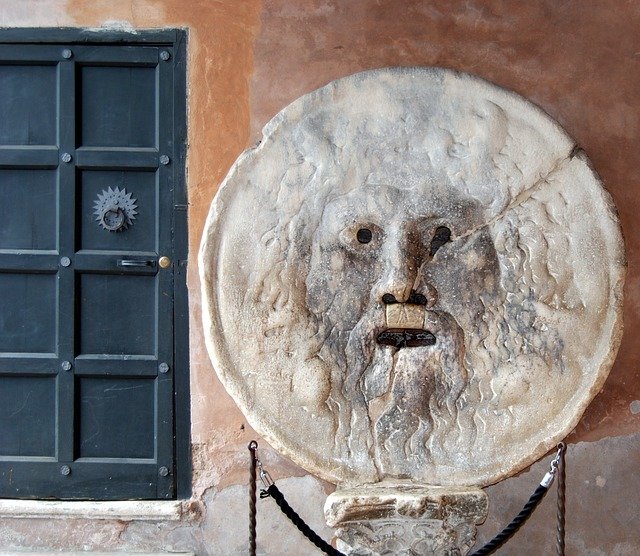
One of the most fascinating artefacts to visit during your Rome tour is the 2,200-year-old “Mouth of Truth”, a worldwide-famous enormous marble mask said to bite the hand of those who lied.
This incredibly large marble mask is found at the Piazza della Bocca della Verita, which is the spot of an ancient cattle market known as the Forum Boarium. The disk is displayed against a portico wall in the Santa Maria Cosmedin Church.
The huge legendary sculpture has a diameter of 1.75 meters and is dedicated to the God of the Sea, represented by a male bearded face with holes for the eyes, nose and mouth. It is very common to see large numbers of people lining up to be photographed with their hand inside the Mouth of Truth. Thousands visit the disc daily with many putting their hand in the mouth to see if it will bite!
The myth says that the disk will bite off the hand of liars, but will do nothing to a truthful person. This idea began in the Middle Ages, when people sought for ways to determine the honesty in agreements. Will you dare to take the test? The Mouth of Truth can be a highlight of your vacation in Rome.
Get lost in Trastevere
Perhaps the most charming neighbourhoods in all of Rome is Trastevere. As you lose yourself down the winding cobblestone streets and dive into an authentic Roman trattoria, you’ll soon discover why everyone falls in love with this magnificent quarter ‘just across the Tiber’ as its name suggests.
Trastevere is one of the prettiest neighbourhoods to visit during your Rome tour, with its narrow cobblestone streets, colourful buildings dripping with ivy, and balconies enlivened with geraniums.
Trastevere is reasonably quiet (at least by day), relaxed, and has far less traffic than other parts of chaotic Rome. It feels more like a small town than a capital city. Yet, it has a convenient location in the historic centre, Vatican, and Colosseum all within a 30-minute walk.
There aren’t many famous sights in Trastevere.
The neighbourhood is more about strolling the streets, people-watching in piazzas, meeting friends for dinner or a drink. In summer restaurant tables spill out onto the streets and the atmosphere is festive.
The Trevi Fountain- one of the world’s most gorgeous fountains
 If you’re planning a Rome tour, chances are you’ve been inspired by many Hollywood films set here: Roman Holiday, La Dolce Vita and even The Lizzie McGuire Film if you’re a millennial. One thing all these three films have in common is that they all feature the most famous fountain in Rome and in the world: the Trevi Fountain.
If you’re planning a Rome tour, chances are you’ve been inspired by many Hollywood films set here: Roman Holiday, La Dolce Vita and even The Lizzie McGuire Film if you’re a millennial. One thing all these three films have in common is that they all feature the most famous fountain in Rome and in the world: the Trevi Fountain.
The fountain dates back to ancient Roman times, since the construction of the Aqua Virgo Aqueduct in 19 B.C. that provided water to the Roman baths and the fountains of central Rome. It’s said that the Aqua Virgo, or Virgin Waters, is named in honour of a young Roman girl who led thirsty soldiers to the source of the spring to drink.
The fountain was built at the end point of the aqueduct, at the junction of three roads. These three streets (tre vie) give the Trevi Fountain its name, the Three Street Fountain.
Because of the legend surrounding it, this fountain is also renowned for hosting a large number of wedding proposals!
Have you been told to throw a coin into the Fontana di Trevi?
The myth, originating in 1954 with the movie “Three Coins in the Fountain,” goes like this:
-If you throw one coin: you will return to Rome.
-If you throw two coins: you will fall in love with an attractive Italian.
-If you throw three coins: you will marry the person that you met.
In order to achieve the desired effect, you should throw the coin with your right hand over your left shoulder!
Just one thing: as one of Rome’s most popular attractions, the Trevi Fountain is always packed with people daily. For photographers seeking an emptier shot, it’s best to head here early in the morning (around 6.30 am) to see it in daylight.
Don’t miss the fountain by night: The Rome fountain completely changes at night, when lights are switched on to illuminate the ivory sculptures, you will live a totally different and atmospheric experience.
The Pantheon – a marvel of Ancient Rome
Just 10 minutes walk from the Trevi Fountain, there is another highlight of any Rome tour – the magnificent Pantheon.
The Pantheon is the best preserved ancient building in Rome and another must-see tourist attraction to add to your list!
The Pantheon, completed in 126AD, was a Roman temple with a surprising oculus that is the building’s main source of natural light.
Though the name refers to a temple to all the gods, the Pantheon is actually the burial place of Rome’s kings and other prominent figures, including Raphael. Don’t hesitate to enter, the visit is free of charge!
A curiosity: the circular building has exactly the same diameter as its height: 43.5 metres. The dome, which has the same diameter, is bigger than that of St. Peter’s Basilica.
Transport yourself to Baroque Rome at Piazza Navona
No trip to Rome is complete without a visit to Piazza Navona,whether it’s to admire the magnificent Baroque architecture or to pick up a souvenir in the art market. Located just a few blocks from the Pantheon, this is one of the most beautiful and popular squares in all of Rome.
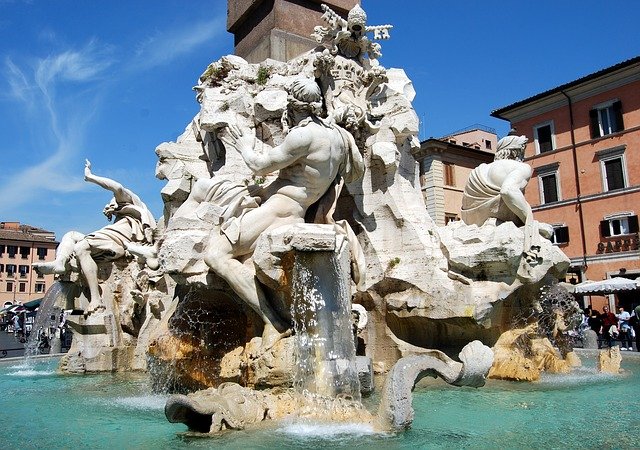 During the day, tourists and locals alike fill the restaurants and the benches of the piazza, while at night it becomes comparatively peaceful. The piazza flaunts Bernini sculptures, elaborate fountains, a magnificent church, colourful cast of street artists and quaint cafes.
During the day, tourists and locals alike fill the restaurants and the benches of the piazza, while at night it becomes comparatively peaceful. The piazza flaunts Bernini sculptures, elaborate fountains, a magnificent church, colourful cast of street artists and quaint cafes.
The main attraction of Piazza Navona is the trio of fountains that adorn the square.
The central and largest fountain is the Fountain of the Four Rivers. Designed by Bernini in 1651, the centrepiece is a tall Roman obelisk surrounded by four figures representing the following rivers: The Ganges, the Danube, the Rio de la Plata, and the Nile.
If you’re travelling to Rome around Christmas, make sure to visit the annual Christmas fair that takes place at Piazza Navona Rome. It goes on from December to early January and is an absolute treat to experience. Don’t miss it during your Rome tour.
Stalls, carousels and nativity at its best, the Piazza Navona is teeming with tourists and locals alike during this period. The square is brimming with festivity and the Christmas spirit wafting through the air is surely contagious!
During the summer, Piazza Navona, Rome has a continuous slew of festivals – Festivals of painters, caricaturists, fortune-teller and buskers, who entertain visitors until the wee hours.
The Spanish Steps at Night: one of the most significant symbols of the romanticism in Rome
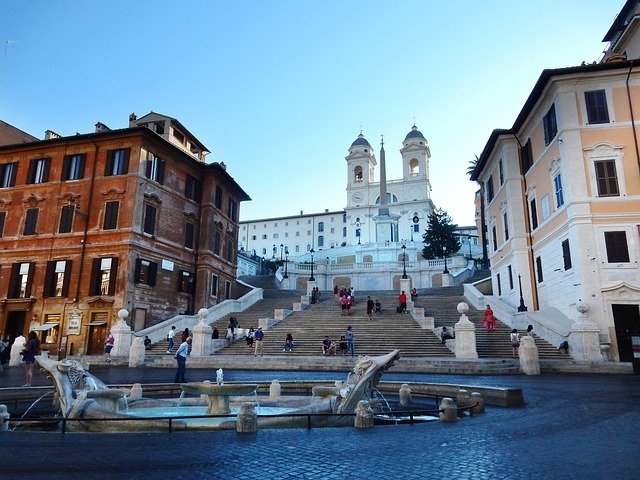
Rome is even more fascinating after dusk, and the Spanish Steps are a great place to stop during your Rome tour and soak up the atmosphere and view of the Eternal City.
Fascinating in its contradictions, the Piazza di Spagna is both democratic and home to the city’s fanciest boutiques on Via dei Condotti, Rome’s legendary shopping street.
Climb the 138 famous steps leading to the Trinità dei Monti church to admire the piazza and Bernini’s ship-shaped fountain from above. If you’re feeling ambitious, climb to the Villa Medici for stunning views of the historical centre.
A curiosity: The Spanish Steps have also made numerous appearances on the silver screen, including in the 1950s film, Roman Holiday, starring Audrey Hepburn and Gregory Peck.
It’s here their characters shared an ice cream on their famous Italian holiday. More recently the steps featured in the film version of the Talented Mr. Ripley, which starred Matt Damon.
Explore the Treasures of Vatican City: St Peter’s Basilica, the Sistine Chapel and Vatican Museums
Wake up early in the morning and be ready to visit one of the seven wonders of the world: St. Peter’s Square, St. Peter’s Basilica and the Vatican Museums, where the Sistine Chapel is located. Don’t miss it during your Rome tour.
It’s possible to visit all three of these attractions in half a day, unless you want to look at everything in the Vatican Museums in detail.
The best way to get to the Vatican city is to take the metro to the Ottaviano line A(red). Upon leaving the station, take the street with the same name until you arrive at St. Peter’s Square, where you will feel the embrace of the Square with its 284 columns and 88 pilasters.
Designed by Bernini during the seventeenth century, it houses over 300,000 people.The square is packed on Sunday mornings for the pope’s midday Angelus. Similarly, on Wednesday morning when the pope meets the faithful.
Enjoy St. Peter’s Basilica: the most important temple in all of Christendom
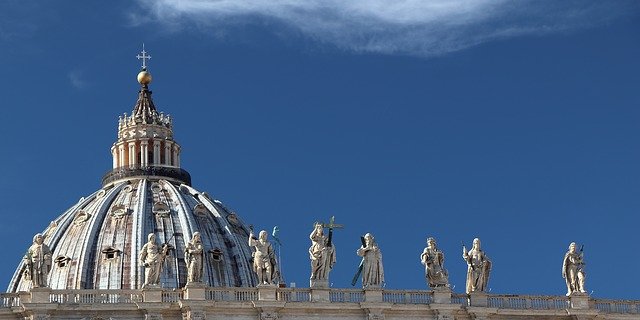
St. Peter’s Basilica is one of the holiest temples for Christendom and one of the largest churches in the world. Besides, it is where the Pope presides many liturgies all year round. St Peter’s Basilica can accommodate 20,000 people.
It measures 190 m (624 ft) long and the central nave is 46 m (150 ft) tall. The dome stands 136 m (447ft) tall. Inside there are incredible works of art, including the altar with Bernini’s Baroque baldacchino and Michelangelo’s moving Renaissance sculpture, Pietà.
For an incredible view from the top of Saint Peter’s Basilica, pay a visit to the splendid Cupola. Going up inside St Peter’s dome is a fantastic, extraordinary experience. You get to see St Peter’s basilica in a whole new way!
Useful information:
- The entrance to the Basilica is free.
- If you want to climb Michelangelo’s dome: Lift to the terrace plus 320 steps: 8€. Climbing 551 steps by foot: 6€. Climbing to the top might prove to be a little oppressive for some, as the last part of the ascent is a narrow and steep spiral staircase.
- The best way to beat the crowds while visiting St. Peter’s Basilica is to arrive as early as possible. This may seem obvious, but fewer travellers than you’d think being able to actually be there by 7 a.m.
- The Dress Code is strictly enforced at St. Peter’s Basilica. No shorts, bare shoulders or mini skirts. This applies to both men and women.
Marvel at the breathtaking Vatican Museums and the Sistine Chapel:

With over 6 million annual visitors, the Vatican Museums are one of the most-popular attractions in Rome. The Vatican Museums contain masterpieces of painting, sculpture and other works of art collected by the popes through the centuries.
The Museums include several monumental works of art, such as the Michelangelo-painted Sistine Chapel, the Chapel of Beato Angelico, the Raphael Rooms and Loggia and the Borgia Apartment. Completed around 1483 the Sistine Chapel is arguably the most famous chapel in the world due to the artwork located within.
You will admire many of the most famous frescoes in the world, including the famous ceiling and The Final Judgement painted by Michelangelo. Not only does the Sistine Chapel hold some of the world’s most precious works of art, but it is also still used for religious purposes such as the Papal Conclave – the process through which a new Pope is chosen.
Useful information
- Admission ticket: Adults: 17€. The entrance is free the last Sunday of every month.
- We suggest you to visit the museum on weekdays around 12 pm. Most people tend to come first thing in the morning to avoid the lines, so this is often the time when you will have to wait the longest. The other way to avoid the lines is to book a guided tour of the Vatican.
- You do not need a special additional ticket to visit the Sistine Chapels outside of the regular museum ticket- it is included as part of your visit to the wider collections. Don’t miss it during your Rome tour.
- You cannot skip the line at the Sistine Chapel, but you can skip the line to get into the Vatican museums.
- During your visit to the Vatican Museums, we recommend you to go first to see the Sistine Chapel and then “pass” to the other artworks.
- There is a dress code for the Sistine Chapel because it is a place of worship. You must have your knees and shoulders fully covered, even in summer.
Castel Sant’Angelo: the headquarters of the illuminati in Dan Brown’s Angels and Demons
 Known as Hadrian’s Tomb, the Castel Sant’Angelo is a fortress located on the right bank of the Tiber, a short distance from the Vatican City.
Known as Hadrian’s Tomb, the Castel Sant’Angelo is a fortress located on the right bank of the Tiber, a short distance from the Vatican City.
If you are not tired, on finishing your visit to the Vatican, take Via della Conciliazione from St. Peter’s Square. On this street is located the Castel Sant’Angelo (Castle of the Holy Angel) and the bridge, Ponte Sant’Angelo, a Roman bridge which is considered one of the most beautiful ones in Rome.
The bridge is decorated with 10 statues representing angels, all designed by Bernini. From the bridge, you will have a magnificent view of the city and the river.
The Castel Sant’Angelo was built as a mausoleum for the emperor Hadrian, later on, it started to play an important military role: it even served as a place of refuge for the popes during invasions! They have even created a direct access to the Vatican.
If you have only 2 days for your Rome tour, aside from the panoramic views and of some splendidly decorated rooms, the internal visit to the Castel Sant’Angelo is not really worth the time.
Piazza del Popolo and the Terrace on the Pincian Hill
The Piazza del Popolo is one of the finest squares in the world and literally translates as the square of the people. Located at the beginning of the Via Flaminia, the Piazza del Popolo is where foreigners arrived in the city during the era of the Empire.
It was the ancient seat of games, exhibitions, folk performances and public executions and today it is one of the most famous piazzas in the world.
In the square you can admire the twin churches of Santa Maria di Montesanto and Santa Maria dei Miracoli, the Obelisco Flaminio (the oldest and the second highest obelisk in Rome), the two fountains by Valadier and the church of Santa Maria del Popolo, built on the spot where the Emperor Nero was buried.
Frequented over the years by artists and other much-loved personalities in the history of Rome, such as Guttuso and Pasolini, Piazza del Popolo is perhaps the cultural emblem of Rome’s true character.
This is the start of the road to the capital’s most famous top shopping venues, such as Via del Babuino and Via Condotti, as well as to one of the most famous promenades of Rome, the one leading to the Terrace of the Pincian Hill. For the most romantic view in Rome: From the square, climb the stairs to the top of the hill.
Immersed in the greenery of Villa Borghese, the Terrace of the Pincian Hill is a splendid balcony overlooking Rome, where you can admire one of the most beautiful views in the world: in fact, it is from here that you can overlook the Eternal City and admire a panorama that is truly unique with views of St. Peter’s Dome, the Vittoriano and the principal monuments that make Rome the most beautiful city in the world. Come here at sundown to enjoy seeing the city at golden hour!
The Villa Borghese Gardens: the ‘Park of Museums’

The Villa Borghese Gardens are located on the Pincian Hill, close to Spanish Steps and Piazza del Popolo.
The Gardens cover an area of 80 hectares and were developed in 1606 by Cardinal Scipione Borghese, who wanted to turn his former vineyard into the most extensive gardens built in Rome. Today, the Villa Borghese Gardens are a vast recreational space and known to have almost 90 attractions listed on the Villa Borghese Map!
These attractions are ideal for all kinds of travellers. Art lovers admire the Borghese Gallery, culture vultures love the Casa del Cinema, parents & kids love the Bioparco and Casina di Raffaello and everybody loves the picturesque gardens and views of the Villa Borghese at the Pincian Hill.
One of the most enchanting spots in Villa Borghese is the artificial lake. If you visit the gardens in a sunny day, take advantage of the boat rental service at the lake to live a romantic experience in the heart-shaped park of Rome!
Row around the canal that flows into the little lake, you’ll be amazed by this charming corner in the middle of the park. Ticket costs only 3 € for adults! Access to Villa Borghese gardens is always free of charge.
See the Vittoriano in its true magnificence at night
 Nothing is more romantic than walking through Rome’s small alleys at night. Romans know this very well as they flood the historical downtown at night to enjoy the several monuments lit by the street lights.
Nothing is more romantic than walking through Rome’s small alleys at night. Romans know this very well as they flood the historical downtown at night to enjoy the several monuments lit by the street lights.
If you feel like it, after having thrown your coin in the Fountain, continue your walk towards Via del Corso and keep going straight to Piazza Venezia. The piazza is located right by the Campidoglio. It’s famous because it features Palazzo del Vittoriano, a monument 81 meter high and 135 meters wide. Its surface is 17000 square meters.
It was designed initially as a memento for Victor Emmanuel II. But the building has taken a different meaning since 1921 because it hosts the remains of the Milite Ignoto (unknown soldier), an Italian soldier killed during WWI and that couldn’t be identified because of his wounds.
Since then the monument is known as Altare della Patria (Altar of the Fatherland) and it celebrates the unity and freedom of the country. Every night the structure is illuminated and admired by both roman citizens and tourists: its facade comes to life thanks to beautiful light effects highlighting the architectural details of this most peculiar building.
A curiosity: Right in the middle of the Piazza is located the famous podium for traffic policemen, featured in many movies and commercials, such as Roman Holiday by William Wyler and To Rome with Love by Woody Allen. Next to the square, there is also the famous Trajan’s column, with bas-reliefs retracing the military conquests of the Emperor Trajan, don’t miss it during your Rome tour.
Rome Travel Tips: Things to know before you go!
- One of the most charming aspects about Rome’s urban typography is its cobblestone streets, but uneven stones can take a toll on your feet. Pack a couple pairs of comfortable walking shoes so you can avoid pain or injury.
- Rome is one of the most touristy city in Italy and chances are you’ll spend your holiday in queues if you do not pre-purchase your tickets in advance.
- If you are going to see a lot of museums during your Rome tour, consider buying one of Rome’s many budget cards such as the Roma Pass, Archeologia card, or the Biglietto 4 Musei (Four Museum Combination Ticket). You pay one flat fee for all the attractions.
- Most museums and restaurants remain closed on Mondays. The Vatican Museums are closed on Sundays, so they tend to be very crowded on Saturdays and Mondays. Plan your Rome tour from Tuesday through Friday instead.
- If you’re planning to visit the St. Peter’s Basilica or any of the other 100 other churches in Rome, make sure you cover up. No matter how hot it is outside, your shoulders and knees must be covered to gain entry.
- Rome’s state-owned museums, galleries, archaeological sites, parks and gardens are free on the first Sunday of each month, so be sure to drop by and soak in some art if you’re in town these days.
- Make sure you carry enough cash with you each day to pay for incidentals like take away pizza or gelato. Even though things are changing, more often than not the smaller shops will only accept cash.
- Don’t pay for water: the city is filled with drinking fountains everywhere you look. These small fountains deliver free-flowing water, gratis, so save your empty water bottles and fill them up all around town.
- In order to avoid eating in an empty restaurant and to really make the most of your evening in Rome, try and fit in with the locals and eat a bit later – around 8.30 p.m. is a good time to sit down.
- See the Roman Appian Way: you’ll be following in the footsteps of the ancient Romans!
- Ascend Gianicolo for Panoramic Views: Roman lovers gather here at dusk. From up here, you can see all the most important monuments: the Spanish Steps, Palazzo Venezia, and beyond. The long and winding road can be quite a hike to the top, so it’s better to go by car or Vespa if you can.
- Find the Secret Keyhole in the Aventino: If you want to impress your fellow travellers, find the nondescript door to the Priory of the Knights of Malta up on the Aventine Hill, just past the orange grove. Peep through the keyhole and you’ll spy a perfect view of Saint Peter’s Basilica across the city.
- Go to the opera in Caracalla (summer): Another glorious Rome location turns theatre during Rome summer nights: the Baths of Caracalla. The baths are an exquisite backdrop for opera nights!
- Where to stay: We recommend to stay somewhere that’s less than a fifteen-minute walk to the main sights and attractions. It might cost a little more, but you’ll save both time on travelling into the city and money on transport.
 Best Time to Visit Rome
Best Time to Visit Rome
Rome is a beautiful city to visit any time of the year. In winter (November to February), the crowds are smaller and the temperatures are mild (3°C-15°C), with the temperature rarely dipping below zero. You can expect to see some rain, but prices are at their lowest. Spring (March to June) and autumn (September to October) are the best times for a mix of good weather conditions, decent prices and smaller crowds. Temperatures range from 5°C-26°C. Summer (July to August) is when the city sights are the busiest and the temperatures are the highest at 18°C-35°C. You should avoid August when many locals leave town and close down their businesses, although tourist businesses will still be open.
Rome Hotels – Where to Stay
Best luxury hotel: NH collection Palazzo Cinquecento 5*, Rome
Stay in the heart of Rome
Set in Piazza del Cinquecento Square in Rome, NH Collection Palazzo Cinquecento offers luxurious accommodation a few steps from Termini Metro and Train Station. Each room and suite come with air conditioning, a mini bar and free WiFi. Some have a terrace and views of the surrounding extensive gardens with Roman ruins.
Best mid-range hotel: Tree Charme Parliament Boutique Hotel 3*
A house of charme in the centre of Rome
Fabulous location right on the edge of Trastevere yet near all the tourist attractions on the other side of Ponte Sisto. Trastevere is lovely, lots of beautiful piazzas, restaurants, churches, picturesque narrow streets, plenty of buskers and nightlife.Nice room with little table and chairs looking out of big window onto square, very lively at night.
Best budget hotel: La Maison d’Art Spagna- Maison d’Art Collection 3*
Excellent location
Featuring free WiFi throughout the property, La Maison D’Art Spagna offers accommodation in Rome, 300 m from Via Condotti. Guests have free entrance to a spa and gym with sun terrace located in a building nearby. A sweet and savoury continental breakfast is available daily. Scrambled eggs and omlettes can be requested and are made to order. Trevi Fountain is 300 m from La Maison D’Art Spagna, while the Spanish Steps are 500 m from the property.




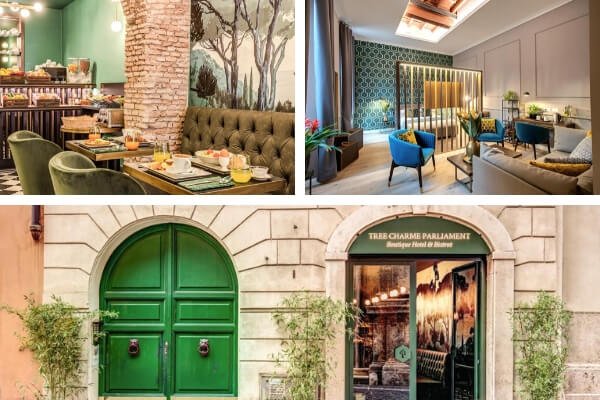
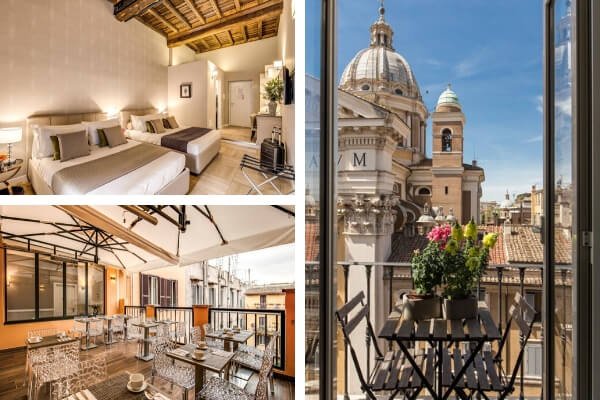

Follow Us